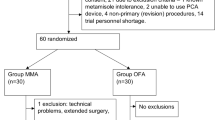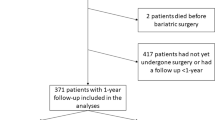Abstract
Publications regarding anesthetic management for weight reduction surgery are scarce. We reviewed the records of 234 patients who underwent bariatric restrictive procedures (gastric bypass not included) from May 1999 to September 2000. Variables analyzed included demographics, anesthetic data and perioperative course. Patients were allocated into two groups: laparoscopic (LPG) and open procedures (OPG), comprising 167 and 67 patients respectively. Obstructive sleep apnea was present in 4.8% in LPG vs 6.1% in OPG. Awake fiberoptic intubation was performed in 3.6% in LPG and 1.5% in OPG. The other patients were anesthetized with rapid sequence induction (classic or modified). Grade III laryngoscopy was present in 6% in LPG and 7.1% in OPG. No intraoperative complications were encountered. Postoperative PACU follow-up time was similar. In both groups, i.v. meperidine was most frequently used for postoperative analgesia (in the PACU), as compared to the other analgesics employed (P<0.03). Early postoperative complications (prolonged mechanical ventilation, unplanned ICU admission, sepsis, re-operation) occurred more frequently in OPG, but the difference between the two groups was statistically insignificant (P<0.08). The length of hospitalization was 3.8±1.4 days in LPG and 6.2±6.6 in OPG (P<0.01). Mortality was zero. Anesthesia for restrictive bariatric surgery (both open and laparoscopic approaches) was associated with few complications.
SUMMARY STATEMENT: We reviewed the records of 234 patients who underwent restrictive bariatric procedures (gastric bypass not included) from May 1999 to September 2000, in regard to perioperative complications. Anesthesia was associated with no intraoperative and few postoperative complications.
This is a preview of subscription content, access via your institution
Access options
Subscribe to this journal
Receive 12 print issues and online access
$259.00 per year
only $21.58 per issue
Buy this article
- Purchase on Springer Link
- Instant access to full article PDF
Prices may be subject to local taxes which are calculated during checkout
Similar content being viewed by others
References
Ogunnaike BO, Jones SB, Jones DB et al. Anesthetic considerations for bariartric surgery. Anesth Analg 2002; 95: 1793–1805.
Sollazzi L, Perilli V, Modesti C, Annetta MG, Ranieri R, Tacchino RM, Proietti R . Volatile anesthesia in bariatric surgery. Obes Surg 2001; 11: 623–626.
Salihoglu Z, Karaca S, Kose Y, Zengin K, Taskin M . Total intravenous anesthesia versus single breath technique and anesthesia maintenance with sevoflurane for bariatric operations. Obes Surg 2001; 11: 496–501.
Alvarez AO, Cascardo A, Albarracin Menendez S, Capria JJ, Cordero RA . Total intravenous anesthesia with midazolam, remifentanil, propofol and cistracurium in morbid obesity. Obes Surg 2000; 10: 353–360.
Pizzirani E, Pigato P, Favretti F, Clemente E, Micaglio M, Lise M, Giron G . The post-anaesthetic recovery in obesity surgery: comparison between two anaesthetic techniques. Obes Surg 1992; 2: 91–94.
Martinotti R, Vassallo C, Ramaioli F, De Amici D, Della Marta ME . Anesthesia with sevoflurane in bariatric surgery. Obes Surg 1999; 9: 180–182.
Bond A . Obesity and difficult intubation. Anaesth Intensive Care 1993; 21: 828–830.
Rocke DA, Murray WB, Rout CC, Gouws E . Relative risk analysis of factors associated with difficult intubation in obstetric anesthesia. Anesthesiology 1992; 77: 67–73.
Ezri T, Medalion B, Weisenberg M et al. Increased body mass index per se is not a predictor of difficult laryngoscopy. Can J Anesth 2003; 50: 179–183.
Meyer RJ . Obesity and difficult intubation. Anaesth Intensive Care 1994; 22: 314–315.
Brodsky JB, Lemmens HJ, Brock-Utne JG et al. Morbid obesity and tracheal intubation. Anesth Analg 2002; 94: 732–736.
Hiremath AS, Hillman DR, James AL et al. Relationship between difficult tracheal intubation and obstructive sleep apnoea. Br J Anaesth 1998; 80: 606–611.
Benumof JL . Obstructive sleep apnea in the adult obese patient: implications for airway management. J Clin Anesth 2001; 13: 144–156.
Ezri T, Khazin V, Warters RD et al. The endotracheal tube moves more often in obese patients undergoing laparoscopy compared with open abdominal surgery. Anesth Analg 2003; 96: 278–282.
Mendonca C, Baguley I, Kuipers AJ et al. Movement of the endotracheal tube during laparoscopic hernia repair. Acta Anaesthesiol Scand 2000; 44: 517–519.
Lobato EB, Paige GB, Brown MM et al. Pneumoperitoneum as a risk factor for endobronchial intubation during laparoscopic gynecologic surgery. Anesth Analg 1998; 86: 301–303.
Inada T, Uesugi F, Kawachi S, Takubo K . Changes in tracheal tube position during laparoscopic cholecystectomy. Anaesthesia 1996; 51: 823–826.
Sharma KC, Brandstetter RD, Brensilver JM, Jung LD . Cardiopulmonary physiology and pathophysiology as a consequence of laparoscopic surgery. Chest 1996; 110: 810–815.
Perilli V, Sollazzi L, Bozza P et al. The effects of reverse Trendelenburg position on respiratory mechanics and blood gases in morbidly obese patients during bariatric surgery. Anesth Analg 2000; 91: 1520–1525.
Sprung J, Whalley DG, Falcone T et al. The impact of morbid obesity, pneumoperitoneum, and posture on respiratory system mechanics and oxygenation during laparoscopy. Anesth Analg 2002; 94: 1345–1350.
Dumont L, Mattys M, Mardirosoff C, Picard V, Alle JL, Massaut J . Hemodynamic changes during laparoscopic gastroplasty in morbidly obese patients. Obes Surg 1997; 7: 326–331.
Feld JM, Laurito CE, Beckerman M, Vincent J, Hoffman WE . Non-opiates analgesia improves pain relief and decreases sedation after gastric bypass surgery. Can J Anaesth 2003; 50: 336–341.
Blaszyk H, Björnsson J . Factor V Leiden and morbid obesity in fatal postoperative pulmonary embolism. Arch Surg 2000; 135: 1410–1413.
Davila-Cervantes A, Borunda D, Dominguez-Cherit G et al. Open versus laparoscopic vertical banded gastroplasty: a randomized controlled double blind trial. Obes Surg 2002; 12: 812–818.
Angrisani L, Furbetta F, Doldi SB et al. Lap band adjustable gastric banding system: the Italian experience with 1863 patients operated on 6 years. Surg Endosc 2003; 17: 409–412.
Author information
Authors and Affiliations
Corresponding author
Rights and permissions
About this article
Cite this article
Ezri, T., Muzikant, G., Medalion, B. et al. Anesthesia for restrictive bariatric surgery (gastric bypass not included): laparoscopic vs open procedures. Int J Obes 28, 1157–1162 (2004). https://doi.org/10.1038/sj.ijo.0802709
Received:
Revised:
Accepted:
Published:
Issue Date:
DOI: https://doi.org/10.1038/sj.ijo.0802709



